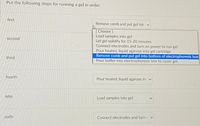
Human Anatomy & Physiology (11th Edition)
11th Edition
ISBN: 9780134580999
Author: Elaine N. Marieb, Katja N. Hoehn
Publisher: PEARSON
expand_more
expand_more
format_list_bulleted
Question

Transcribed Image Text:**Steps for Running a Gel**
To properly conduct gel electrophoresis, follow the steps below in their correct order:
1. **First**: Pour heated, liquid agarose into gel cartridge
2. **Second**: Let gel solidify for 15-20 minutes
3. **Third**: Remove comb and put gel into the bottom of the electrophoresis box
4. **Fourth**: Pour buffer into the electrophoresis box to cover the gel
5. **Fifth**: Load samples into gel
6. **Sixth**: Connect electrodes and turn on power to run the gel
This sequence ensures the successful preparation and execution of the electrophoresis process.
Expert Solution
This question has been solved!
Explore an expertly crafted, step-by-step solution for a thorough understanding of key concepts.
This is a popular solution
Trending nowThis is a popular solution!
Step by stepSolved in 3 steps

Knowledge Booster
Similar questions
- The benefits of the negative stain include: Mark all that apply: O No shrinkage or distortion of cells due to no heat or methanol fixing Because the cells don't take up stain they don't get shrunk or distorted O One can more accurately determine cell size and shape because the cells stand out against the background One can more accurately determine the cell size and shape because there is no shrinkage or distortion of cells O Negatively charged dyes are safer to work with than positively charged dyes IMicrosoft B 11:32 Aarrow_forwardNegatively charged proteins migrate towards the top of the gel backwards towards the positive electrode slower than positively charged proteinsarrow_forwardBefore viewing a specimen of pigmented bacteria on a slide under the light microscope, which of the following usually needs to happen (and why)? Staining (to increase magnification). Heat, radiation or antimicrobial chemical treatment (to kill the bacteria for safe observation). Add immersion oil (to increase resolution). Add a cover slip (to reduce contamination). The viewing chamber needs to be flushed of air (to create a vacuum).arrow_forward
- General Electrophoresis Questions: 1. What makes macromolecules move through the gel in electrophoresis?2. What determines the speed at which macromolecules move through the gel in electrophoresis? In a single gel, why do some move faster than others?3. Why do we use different procedures for DNA and protein electrophoresis?arrow_forwardI missed a couple of my labs due to covid and am struggling to teach myself how to do serial dilution, dilution, dilution factors, and colony forming units per ml of original stock. I thought I was understanding everything until it was time for me to take the practice quiz and I realized that I understood nothing.arrow_forwardWhat is the main advantage of fluorescence polarization? Sensitivity of fluorescent probes Low cost of instrument and reagents Compatibility of reagents with most analytes No need to purify samples Easy to attach fluorescent probearrow_forward
- 21 22 23 24 Short Essay: Answer the prompt in 4 sentances or less. Describe the staining technique used to create the photo. Make sure to describe the structures indicate by the arrow in letter A and the structures circled in letter B. Is this a simple or differential stain? Explain your answer. 1- OB 10 μmarrow_forwardGive typed full explanationarrow_forwardCan your draw it out and explain it to me pleasearrow_forward
- Questions 11-14. Melia and Sophie performed a PCR experiment using DNA purified from their phage Zucchinibread. They did a positive control, a negative control, and an experiment using subcluster B1 primers. They ran a 0.8% gel (shown below). 10кb 3Kb 1Kb 0.5Kb -A IKB DNA Ladder Negative Control Positive Control Phage DNA+ B1 Primersarrow_forwardThe above photograph (IMAGE ATTACHED) of a cheek smear was obtained using the high-power objective of a compound microscope. What is the size of the circled cheek cell in millimeters AND nanometers?arrow_forwardThe first step in identifying an unknown bacterium is to __________. The first step in identifying an unknown bacterium is to __________. culture your unknown on selective media perform endospore staining on your culture prepare a pure working stock simple staining on your culture acid-fast staining on your culturearrow_forward
arrow_back_ios
SEE MORE QUESTIONS
arrow_forward_ios
Recommended textbooks for you
 Human Anatomy & Physiology (11th Edition)BiologyISBN:9780134580999Author:Elaine N. Marieb, Katja N. HoehnPublisher:PEARSON
Human Anatomy & Physiology (11th Edition)BiologyISBN:9780134580999Author:Elaine N. Marieb, Katja N. HoehnPublisher:PEARSON Biology 2eBiologyISBN:9781947172517Author:Matthew Douglas, Jung Choi, Mary Ann ClarkPublisher:OpenStax
Biology 2eBiologyISBN:9781947172517Author:Matthew Douglas, Jung Choi, Mary Ann ClarkPublisher:OpenStax Anatomy & PhysiologyBiologyISBN:9781259398629Author:McKinley, Michael P., O'loughlin, Valerie Dean, Bidle, Theresa StouterPublisher:Mcgraw Hill Education,
Anatomy & PhysiologyBiologyISBN:9781259398629Author:McKinley, Michael P., O'loughlin, Valerie Dean, Bidle, Theresa StouterPublisher:Mcgraw Hill Education, Molecular Biology of the Cell (Sixth Edition)BiologyISBN:9780815344322Author:Bruce Alberts, Alexander D. Johnson, Julian Lewis, David Morgan, Martin Raff, Keith Roberts, Peter WalterPublisher:W. W. Norton & Company
Molecular Biology of the Cell (Sixth Edition)BiologyISBN:9780815344322Author:Bruce Alberts, Alexander D. Johnson, Julian Lewis, David Morgan, Martin Raff, Keith Roberts, Peter WalterPublisher:W. W. Norton & Company Laboratory Manual For Human Anatomy & PhysiologyBiologyISBN:9781260159363Author:Martin, Terry R., Prentice-craver, CynthiaPublisher:McGraw-Hill Publishing Co.
Laboratory Manual For Human Anatomy & PhysiologyBiologyISBN:9781260159363Author:Martin, Terry R., Prentice-craver, CynthiaPublisher:McGraw-Hill Publishing Co. Inquiry Into Life (16th Edition)BiologyISBN:9781260231700Author:Sylvia S. Mader, Michael WindelspechtPublisher:McGraw Hill Education
Inquiry Into Life (16th Edition)BiologyISBN:9781260231700Author:Sylvia S. Mader, Michael WindelspechtPublisher:McGraw Hill Education

Human Anatomy & Physiology (11th Edition)
Biology
ISBN:9780134580999
Author:Elaine N. Marieb, Katja N. Hoehn
Publisher:PEARSON

Biology 2e
Biology
ISBN:9781947172517
Author:Matthew Douglas, Jung Choi, Mary Ann Clark
Publisher:OpenStax

Anatomy & Physiology
Biology
ISBN:9781259398629
Author:McKinley, Michael P., O'loughlin, Valerie Dean, Bidle, Theresa Stouter
Publisher:Mcgraw Hill Education,

Molecular Biology of the Cell (Sixth Edition)
Biology
ISBN:9780815344322
Author:Bruce Alberts, Alexander D. Johnson, Julian Lewis, David Morgan, Martin Raff, Keith Roberts, Peter Walter
Publisher:W. W. Norton & Company

Laboratory Manual For Human Anatomy & Physiology
Biology
ISBN:9781260159363
Author:Martin, Terry R., Prentice-craver, Cynthia
Publisher:McGraw-Hill Publishing Co.

Inquiry Into Life (16th Edition)
Biology
ISBN:9781260231700
Author:Sylvia S. Mader, Michael Windelspecht
Publisher:McGraw Hill Education